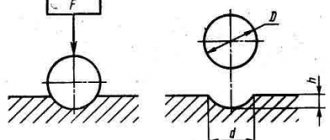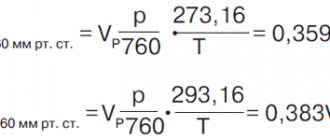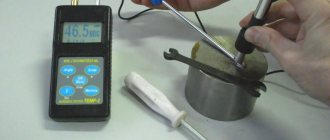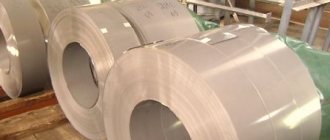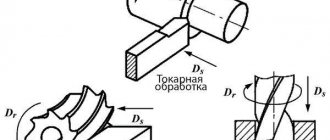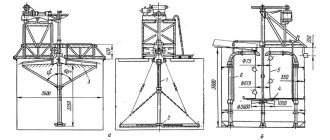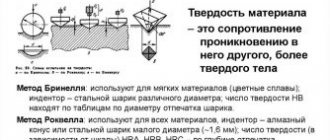Concept
This term in materials science refers to a mechanical property that determines resistance to destruction under the influence of other, denser substances. Otherwise we can say this: this is resistance to deformation from pressure. In this case, both plastic and elastic changes are taken into account.
Many processes and conditions depend on the characteristics:
- Wear resistance is how long an element can be used. This includes wear and tear, since for every part, such as a car part, there comes a time when, for natural reasons, it needs to be replaced. But the harder the element, the longer it will last under certain conditions.
- Possibility of various types of metalworking - some technologies are applied only to soft alloys, while others can be used for durable ones.
- Resistance to pressure and other forces is characteristic of a shaft or bearing that is subject to centrifugal and frictional forces.
- The ability to use a material as a tool for a more pliable surface. Tool steel is so strong that it is used to make cutters for milling machines, drills and other products.
This is not a complete list of what the hardness of a metal affects after we have defined it. Not every substance used has the same characteristics. What is done first of all to increase this parameter? First, we take raw materials, clean them of impurities, and then subject them to chemical and temperature treatment. Namely: we add various alloying components to the composition that increase this quality, for example:
- Chromium. Strength and corrosion resistance increases, ductility and susceptibility to magnetic forces are slightly reduced. If more than 13% chromium, then the alloy is called stainless.
- Tungsten. The content of solid compounds – carbides – increases greatly. An additional property is reduced brittleness after tempering.
- Vanadium. The resistance to deformation also increases.
- Manganese. To see the effect, the substance must be at least 1%. Impact resistance skyrockets.
What determines the hardness of metals in this class:
- From the presence of alloying additives listed above.
- From the natural properties of raw materials.
- From heat treatment. Hardening helps for this purpose - the material is heated above a certain critical point, the crystal lattice changes, and after cooling, the hardened steel becomes very reliable.
- From cementation - by diffusion, the sample is saturated with carbon. Only low carbon or alloy parts are subjected to this method.
- From aging - it can be natural or artificial. In the first case, processes occur over time that do not affect the microstructure, but are important at the general level. In the second, heat treatment is used to chemically and thermally increase the service life - aging.
- From hardening to the surface. This is a plastic change in the structure of a substance, leading to an increase in strength.
- From laser processing. The laser machine deposits a durable layer.
In addition, some stages of metalworking (rolling, forging and hardening) with changes in the shape of the workpiece also lead to improved quality.
Elongation (at break)
Often called "relative elongation". An increase in the distance between two marks on a test specimen that occurs as a result of the specimen deforming under tension until it breaks between the marks.
The amount of elongation depends on the cross-sectional dimensions of the sample. For example, the amount of elongation that is obtained when testing an aluminum sheet specimen will be lower for a thin sheet than for a thick sheet. The same applies to extruded aluminum profiles.
Figure 5 – Influence of alloying elements on strength properties and relative elongation [4]
Extension A
Percentage elongation after specimen rupture at an initial mark spacing of 5.65 √ S0, where S0 is the initial cross-sectional area of the test specimen. The outdated designation of this quantity A5 is currently not used. A similar value in Russian-language documents is designated δ5.
It is easy to check that for round samples this distance between the original marks is calculated as 5·d.
Extension A50mm
The percentage elongation after specimen rupture, relative to the original length between the 50 mm marks and the constant original width of the test specimen (typically 12.5 mm). In the USA, a distance between marks of 2 inches is used, that is, 50.8 mm.
In what units is the hardness of a metal measured?
The peculiarity of this characteristic is that depending on the method by which the measurement was carried out, the classical designation also changes. Since the parameter cannot be classified among the main physical scales, such as distance, speed, mass, force, there is no single standard in the so-called SI system.
If the researcher uses one of the most standard methods proposed by Brinnell, which we will discuss in more detail below, then the result will be written in kgf/mm2, that is, in kilogram-force divided by square millimeter. Using the scale for measuring the hardness of metals, we can talk about classical examples and their indicators in relation to each other:
- iron alloys - on average 30 kgf/mm2;
- copper and nickel compositions – 10 kgf/mm2;
- aluminum, magnesium and their derivatives – 5 kgf/mm2.
So we conclude that iron is 6 times harder than the soft aluminum compound.
The second popular method was invented by Rockwell. According to it, one conditional value (cu) is equal to the displacement of the cone by 2 microns. If it is marked according to this option, then the indexing is first indicated, then one of three letters - A, B, C and a digital value. If you see the hardness of the HB material on the workpiece, then these are Rockwell units of measurement. Parts marked HR can also be marked with an index, and after 1 of three letters:
- A - indicates that the tests were carried out using a diamond cone with an apex angle of 120 degrees under an applied load of 50 - 60 kg.
- B - speaks of a ball of one-sixteenth of an inch, which is directed to the surface under a weight of 90 - 100 kg.
- C - a similar cone is used as with marking A, but the impact is increased at 140 - 150 kg.
Next comes a number that already indicates what kind of dent has formed.
And another option for how steel hardness is measured is numbers plus the letters HV. Vickers proposes this measurement. While using Shor’s method you can see the following records – 90 HSD.
Steel hardness index
The highest HRC is not necessarily the best.
Harder steel tends to hold an edge better than softer steel, but it is also more likely to crack or fail. In fact, if it's really hard, it can break like glass on concrete!
The steel used to make a knife also has a lot to do with how well the knife will hold an edge. Each individual steel alloy has its own optimal range that balances hardness with performance and purpose.
So why does a knife's Rockwell Score matter? What is a good Rockwell hardness for a knife?
The hardness of a knife is very important in terms of its performance and durability. For example, a harder steel with an RC of 58-62 will hold an edge better than a softer steel. However, this same hard steel is less strong and more prone to cracking or even breaking.
Some kitchen knives with high hardness require special care to avoid damaging the thin cutting edge
Softer steel is more durable due to its high elasticity. Most axes and chisels use softer steel to withstand the impacts they encounter in everyday work.
Since pocket knives and hunting knives are not typically used for planing and chopping wood, they benefit from using stronger steel that maintains excellent sharpness for cutting soft materials.
However, a survival knife that you're going to put extreme effort into will benefit from a Rockwell hardness of 55-58. A knife that could cut bones and hard wood must first of all be durable. A knife with a lower hardness may become dull faster, but is more likely to survive a large number of impacts and mechanical damage.
Rockwell testing helps knife makers balance the three most important factors that can affect the quality of their finished products: hardness, flexibility and toughness. Having these three factors in the right balance allows them to produce knives for a variety of uses.
There are several different abbreviations that may be used by a knife maker when specifying hardness: HR, HRc, HR C, RC, Rc, Rockwell C, Rockwell C. Regardless of how knife steel is written, they all refer to one and the same C scale. This can get a little confusing, but just know that the ratings themselves are the same - no matter what designation the manufacturer uses.
Stanley P. Rockwell was a metallurgist at a New England ball bearing plant in 1919. He developed a hardness scale to measure the hardness of bearing balls quickly, accurately and with high repeatability.
Manufacturers of everything from watch springs to train wheels have long needed such testing and quickly adopted the Rockwell scale for all types of steel, as well as other metal parts. Eventually, the test was even adapted to test non-metallic materials—even plastics.
How Hard Are Base Metals?
Most materials already have certain characteristics, they have long been measured and recorded in tables, while the reports indicate both the initial values of raw iron and after various types of heat and cold metal working. But when adding non-standard and new additives or procedures, it is necessary to re-measure this indicator. But if you are faced with standard alloys, then you should look at the prepared lists.
Tsvetmet
They are softer than black because they do not contain hard inclusions, and they are not subjected to hardening or other heat treatment methods.
Titan is an exception. Here is the technology used by Brinnell:
| Material | Peculiarities | In NV |
| Copper | It has high ductility and low strength. if special impurities are added, new brands are obtained, then the indicator may increase. | 35 |
| Brass | This is a double or multi-component composition that includes copper. but it is more reliable, zinc or tin are additionally included. | 42 – 60 |
| Aluminum | May be soft or hard, with increased or decreased ductility. | 15 – 20 |
| Duralumin | Modern, lightweight, actively used in aircraft construction. There are additives - copper, magnesium, manganese. | 70 |
| Titanium | Very strong non-ferrous metal. | 160 |
Black metals
These are iron and steel, ferroalloys and cast iron. Sometimes vanadium and manganese are included in this category. General characteristics:
- The method of production is the processing of iron ore.
- Increased strength.
- Immunity to mechanical influences.
- High wear resistance.
- Good weldability.
- Low cost.
Therefore, iron is actively used. It is inappropriate to provide a complete list of all brands, so only the main ones:
- Cast iron - 220 HB.
- Tool steel alloys - up to 700 HB, cutting tools are made from it.
- Stainless steel – up to 250 HB.
How to determine the hardness of a metal using the Brinell method: features
An ideal ball with a diameter of 1 to 10 millimeters is used as an indenter, that is, the element itself that is pressed into the workpiece. It is made from alloy compounds or from an alloy of carbide and tungsten. The production of such balls is regulated by GOST 3722 81.
The time during which static, that is, motionless indentation occurs, is from 10 to 180 seconds. This parameter depends on the material. The shortest time intervals are for cast iron and steel, and longer ones are for non-ferrous metals.
The maximum load that can be measured in this way is 450 or 650 NB, depending on what the ball is made of.
An effect is selected on the sample for the correct deformation; let’s look at the formulas in the table to see how they can be calculated, taking into account that D is the diameter of the ball:
| Object being checked | Mathematical calculated change |
| Lead or tin | 1d^2 |
| Steel connections, titanium, nickel | 30d^2 |
| Light alloys | from 2.5d^2 to 15d^2 |
| Cast iron | 10d^2 or 30d^2 |
| Copper and compositions containing it | 5d^2, 10d^2, 30d^2 |
Algorithm for applying the Brinell method
- The device itself and the body for implementation - the ball - are checked.
- The maximum force is determined.
- The hardness tester starts.
- The depth of indentation is measured.
- Mathematical calculations are performed.
The applied formula is HB=P/F, where:
- P – load;
- F – print area.
It should be noted that this is the most common method.
Hardness measurement methods
All methods for determining the hardness of metals use mechanical action on the test sample - indentation of an indenter.
But this does not destroy the sample. The Brinell hardness method was the first to be standardized in materials science. The principle of testing samples is described above. It is subject to GOST 9012. But you can calculate the value using the formula if you accurately measure the imprint on the sample:
HB=2P/(πD*√(D 2 -d 2 ),
- where P – applied load, kgf;
- D – ball circumference, mm;
- d – circumference of the imprint, mm. The ball is selected relative to the thickness of the sample. The load is calculated in advance from accepted standards for the relevant materials: iron alloys - 30D 2 ; copper and its alloys - 10D 2 ; babbits, lead bronzes - 2.5D 2 .
Symbol of the test principle
Schematically, the Rockwell research method is depicted as follows according to GOST 9013.
Rockwell hardness test method
The final applied load is equal to the sum of the initial load and that required for the test. The device indicator shows the difference in penetration depth between the initial load and the test load h –h
The Vickers method is regulated by GOST 2999. It is schematically depicted as follows.
Mathematical formula for calculation: HV=0.189*P/d 2 MPaHV=1.854*P/d 2 kgf/mm 2 The applied load varies from 9.8 N (1 kgf) to 980 N (100 kgf). The values are determined from the tables relative to the measured print d.
The method is considered empirical and has a wide range of readings. But the device has a simple design and can be used when measuring large-sized and curved parts.
The Mohs hardness of metals and alloys can be measured by scratching. Mohs at one time proposed making scratches on the surface of an object with a harder mineral. He classified known minerals by hardness into 10 positions. The first is occupied by talc, and the last by diamond.
After measurement using one method, transfer to another system is very conditional. Clear values exist only in the Brinell and Rockwell hardness ratios, since machine-building enterprises widely use them. The dependence can be observed when the diameter of the ball changes.
| d, mm | HB | HRA | H.R.C. | HRB |
| 2,3 | 712 | 85,1 | 66,4 | — |
| 2,5 | 601 | 81,1 | 59,3 | — |
| 3,0 | 415 | 72,6 | 43,8 | — |
| 3,5 | 302 | 66,7 | 32,5 | — |
| 4,0 | 229 | 61,8 | 22 | 98,2 |
| 5,0 | 143 | — | — | 77,4 |
| 5,2 | 131 | — | — | 72,4 |
As can be seen from the table, increasing the diameter of the ball significantly reduces the readings of the device. Therefore, machine-building enterprises prefer to use measuring instruments with the same type of indenter size.
If you find an error, please select a piece of text and press Ctrl+Enter.
How to measure metal hardness using the Rockwell method: features
If the previous technology is called classical, then this one can be called modern, since it is more automated. The accuracy is much higher and the scope of application is also much higher, since you can work even with very durable materials.
Characteristics of the method:
- The initial pressure is 10 kgf.
- The voltage is maintained from 10 seconds to 1 minute.
- The result is not calculated mathematically, it is displayed on a digital display.
- Different tips are used, depending on this, markings are placed, which begin with the letters A, B, C. We have already indicated in more detail the decoding of the indices, just recall that a steel ball or a diamond cone can act as an indenter.
There are also lesser known and used E, H, K scales with a smaller diameter ball. The procedure is subject to restrictions:
- It is possible to make tests on one workpiece only at a distance of 3-4 units, equal to the size of the testing object, from each other.
- The thickness cannot be less than the depth of penetration of the tip into the steel multiplied by 10.
Rockwell Study Design
The algorithm is similar and even more simplified:
- It is necessary to evaluate the part and check the functionality of the machine.
- Calculate the maximum load.
- Mount the sample and apply primary stress.
- Maintain a certain period of time.
- Record the result indicated on the scoreboard.
Let's see what a hardness tester looks like and how to use it:
Hardness measurement methods
All methods for determining the hardness of metals use mechanical action on the test sample - indentation of an indenter. But this does not destroy the sample.
The Brinell hardness method was the first to be standardized in materials science. The principle of testing samples is described above. It is subject to GOST 9012. But you can calculate the value using the formula if you accurately measure the imprint on the sample:
HB=2P/(πD*√(D 2 -d 2 ),
- where P – applied load, kgf;
- D – ball circumference, mm;
- d – circumference of the imprint, mm. The ball is selected relative to the thickness of the sample. The load is calculated in advance from accepted standards for the relevant materials: iron alloys - 30D 2 ; copper and its alloys - 10D 2 ; babbits, lead bronzes - 2.5D 2 .
Symbol of the test principle
Schematically, the Rockwell research method is depicted as follows according to GOST 9013.
Rockwell hardness test method
The final applied load is equal to the sum of the initial load and that required for the test. The device indicator shows the difference in penetration depth between the initial load and the test load h –h
The Vickers method is regulated by GOST 2999. It is schematically depicted as follows.
Mathematical formula for calculation: HV=0.189*P/d 2 MPaHV=1.854*P/d 2 kgf/mm 2 The applied load varies from 9.8 N (1 kgf) to 980 N (100 kgf). The values are determined from the tables relative to the measured print d.
The method is considered empirical and has a wide range of readings. But the device has a simple design and can be used when measuring large-sized and curved parts.
The Mohs hardness of metals and alloys can be measured by scratching. Mohs at one time proposed making scratches on the surface of an object with a harder mineral. He classified known minerals by hardness into 10 positions. The first is occupied by talc, and the last by diamond.
After measurement using one method, transfer to another system is very conditional. Clear values exist only in the Brinell and Rockwell hardness ratios, since machine-building enterprises widely use them. The dependence can be observed when the diameter of the ball changes.
| d, mm | HB | HRA | H.R.C. | HRB |
| 2,3 | 712 | 85,1 | 66,4 | — |
| 2,5 | 601 | 81,1 | 59,3 | — |
| 3,0 | 415 | 72,6 | 43,8 | — |
| 3,5 | 302 | 66,7 | 32,5 | — |
| 4,0 | 229 | 61,8 | 22 | 98,2 |
| 5,0 | 143 | — | — | 77,4 |
| 5,2 | 131 | — | — | 72,4 |
As can be seen from the table, increasing the diameter of the ball significantly reduces the readings of the device. Therefore, machine-building enterprises prefer to use measuring instruments with the same type of indenter size.
If you find an error, please select a piece of text and press Ctrl+Enter.
The hardness of a metal is its property of resisting plastic deformation during the contact action of a standard tip body on the surface layers of the material.
Hardness testing is the main method for assessing the quality of heat treatment of a product.
Determination of hardness using the Brinell method. The method is based on inserting a steel ball into a flat surface under load. Hardness number HB
determined by the ratio of the load to the spherical surface of the print.
The Rockwell (HR) method is based on statically pressing a tip into the test surface under a certain load. Steel balls are used as tips for materials with hardness up to 450 HR. In this case, the hardness is designated as HRB
.
When using a diamond cone, hardness is designated as HRA
or
HRC
(depending on load).
Vickers hardness (HV) is determined by statically pressing a diamond tetrahedral pyramid into the test surface. During the test, the indentation is measured with an accuracy of 0.001 mm using a microscope, which is an integral part of the Vickers instrument.
Shor's method. The essence of this method is to determine the hardness of the sample material by the height of the rebound of the striker falling onto the surface of the test body from a certain height. Hardness is assessed in conventional units proportional to the height of the striker's rebound.
Characteristics of the Vickers technique
Another very simple method, which is distinguished by speed and accuracy, but the high cost of equipment. Let's list the features:
- A diamond pyramid with a more obtuse angle is used - 136 degrees at the apex.
- Deformation of more than 100 kgf is not allowed.
- The time taken is very short - from 10 to 15 seconds.
- You can measure the parameters of any material, including especially durable ones, as well as steels that have undergone heat treatment.
Sequence of research
Simplified algorithm:
- Check the surface layer of the part, as well as all equipment.
- Calculate the allowable force.
- Install the sample and secure it.
- Start the device and after 10-15 seconds analyze the result.
Ways to switch between scales
The fact that laboratories use different methods, as well as the fact that there is no single standard, means that one indicator has to be converted to another number system. It should be noted that in all countries one technology is predominantly chosen. But due to active trade turnover, manufacturers encounter unusual markings. So, let's give a table with similar results for different data:
| Indentation diameter – in mm | According to Brinell | According to Rockwell, category A | IN | WITH | According to Vickers |
| 3,9 | 241 | 62,8 | 99,8 | 24 | 242 |
| 4,08 | 217 | 60,7 | 96,6 | 20,2 | 217 |
| 4,2 | 206 | 59,6 | 94,6 | 17,9 | 206 |
| 5 | 144 | 49,9 | 77,7 | – | 144 |
It may be noted that the lists are not particularly accurate, since depending on the measurements, a variety of alloys could be used. The reports will be correct only if the same material was tested in all five methods.
